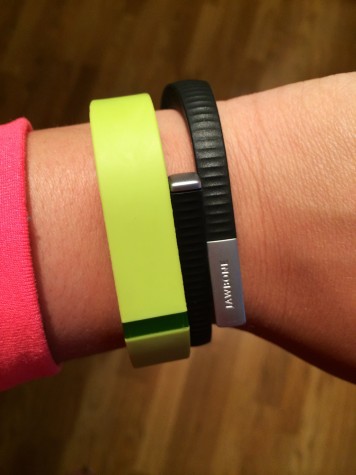Track your fitness on your wrist
Wearable sensors, such as the Fitbit, Nike FuelBand, and Jawbone UP have become a “mainstay of the fitness world” and a growing $330 million industry, according to NPD Group, which tracks digital fitness devices. While they offer users an easy way to track their movement, passively using these wearables won’t help boost fitness or overall health. There are steps needed to take, like imputing food intake in the connected app, to ensure you make the most of them.
Here’s how they work: Slip the sensor into your pocket or around your wrist, and it will track your steps, distance traveled, flights of stairs walked, calories burned and, depending on the brand, your sleep patterns. The sensor then uploads that information online or to an app, giving you the opportunity to track your progress over time. Student Rachel Hernandez (12) says, “FitBits are great for anyone who wants to become more active, or for people who already love fitness.”
There are a ton of features to love with exercise bands. Steven Daniel’s (12) favorite part of his FitBit Flex is the “silent alarms to wake up in the morning.” On the app, you program a time you want to wake up, and the bracelet or pocket piece will vibrate to gently wake you at the specified time. Mr. Korney Often, you can set up multiple silent alarms to occur once or on multiple days of the week. An awesome benefit of this alarm is that it recognizes when you’re in a light sleep cycle, then fires the alarm within a 10-minute window of the set time. The theory behind this is that you’ll wake up fresher by waking up in the middle of light sleep rather than deep. Mr. Korney say’s, “I love looking at my sleep patterns.”
“The app is useful because it helps you realize what is actually going into your body and how it is impacting you. It really helps you to be healthy and keep yourself in check,” Daniel’s adds.
FitBit (left) and Jawbone UP (right).
A very cool feature of the FitBit Flex is that it factors in metabolism to your calorie intake. Each morning, Daniels starts off with “around 1,900 calories to eat, but as the day goes on, that number gets greater simply with metabolism.” Most brands and apps hold the feature where you input the food you eat and therefore the calorie intake, but taking metabolism along with exercise into the equation allows the consumer to see extremely accurate data about their body.
“I like that it blends in well with my clothes and is discreet, it’s not huge and bulky so that’s nice,” Frances Ferolo (10) says about when addressing the visual aspect of the bands.
Not only does it’s appearance make it easy to wear on the daily, but it also allows athletes to wear them while practicing or playing a school sport. Cameron Overbeck (9), says “It’s really useful for tracking mileage for cross country and track and seeing my running stats,” and Sean Collins (9) says “It helps me track my running and heart rate in soccer, and the fact that I can wear it while I play is cool.”
Continuous heart rate tracking. Slim design. Affordable price. Works with Windows, iPhones, and Android phones. Massive popularity means you’ll be able to join up and compete with friends- creating workout accountability. Also, connecting with many third-party fitness apps leads to another push towards a healthier lifestyle. The bottom line, exercise bands are a hard combination to beat.

